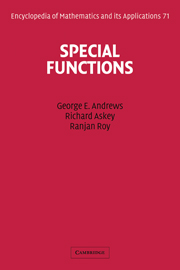Book contents
- Frontmatter
- Contents
- Preface
- 1 The Gamma and Beta Functions
- 2 The Hypergeometric Functions
- 3 Hypergeometric Transformations and Identities
- 4 Bessel Functions and Confluent Hypergeometric Functions
- 5 Orthogonal Polynomials
- 6 Special Orthogonal Polynomials
- 7 Topics in Orthogonal Polynomials
- 8 The Selberg Integral and Its Applications
- 9 Spherical Harmonics
- 10 Introduction to q-Series
- 11 Partitions
- 12 Bailey Chains
- A Infinite Products
- B Summability and Fractional Integration
- C Asymptotic Expansions
- D Euler–Maclaurin Summation Formula
- E Lagrange Inversion Formula
- F Series Solutions of Differential Equations
- Bibliography
- Index
- Subject Index
- Symbol Index
8 - The Selberg Integral and Its Applications
Published online by Cambridge University Press: 05 May 2013
- Frontmatter
- Contents
- Preface
- 1 The Gamma and Beta Functions
- 2 The Hypergeometric Functions
- 3 Hypergeometric Transformations and Identities
- 4 Bessel Functions and Confluent Hypergeometric Functions
- 5 Orthogonal Polynomials
- 6 Special Orthogonal Polynomials
- 7 Topics in Orthogonal Polynomials
- 8 The Selberg Integral and Its Applications
- 9 Spherical Harmonics
- 10 Introduction to q-Series
- 11 Partitions
- 12 Bailey Chains
- A Infinite Products
- B Summability and Fractional Integration
- C Asymptotic Expansions
- D Euler–Maclaurin Summation Formula
- E Lagrange Inversion Formula
- F Series Solutions of Differential Equations
- Bibliography
- Index
- Subject Index
- Symbol Index
Summary
Dirichlet's straightforward though useful multidimensional generalization of the beta integral was presented in Chapter 1. In the 1940s, more than 100 years after Dirichlet's work, Selberg found a more interesting generalized beta integral in which the integrand contains a power of the discriminant of the n variables of integration. Recently, Aomoto evaluated a yet slightly more general integral. An important feature of this evaluation is that it provides a simpler proof of Selberg's formula, reminiscent of Euler's evaluation of the beta integral by means of a functional equation. The depth of Selberg's integral formula may be seen in the fact that in two dimensions it implies Dixon's identity for a well-poised 3F2. Bressoud observed that Aomoto's extension implies identities for nearly poised 3F2.
After presenting Aomoto's proof, we give another proof of Selberg's formula due to Anderson. This proof is similar to Jacobi's or Poisson's evaluation of Euler's beta integral in that it depends on the computation of a multidimensional integral in two different ways. The basis for Anderson's proof is Dirichlet's multidimensional integral mentioned above. A very significant aspect of Anderson's method is that it applies to the finite-field analog of Selberg's integral as well. We give a brief treatment of this analog at the end of the chapter.
- Type
- Chapter
- Information
- Special Functions , pp. 401 - 444Publisher: Cambridge University PressPrint publication year: 1999
- 1
- Cited by



